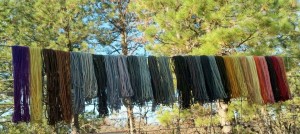

This array of dyes was produced at a workshop taught by Alissa Allen in December 2013, held near my home. The mushrooms and lichens used were found throughout California and the Pacific Northwest.
It is time to open the 2014 CSA Share subscriptions! I have just re-tooled my Fibershed Marketplace listing to offer a Drought Share this year. As I discussed a few weeks ago, the prospect for adequate water here in California during the 2014 growing season is dire. Last week, my own water district put into place a rate structure that includes water overage rates four times higher than last year, and the option of dramatically reducing what is provided to customers if a ‘drought emergency’ (meaning dramatically low water in this district) comes about. My husband and I have discussed in great detail the various ways we will work to keep our perennial plantings alive, including dry farming our wine grapes, using drip irrigation and timers (which we have already been employing) and heavy mulching on our perennial and food garden beds. However, I have come to the conclusion that I will need to grow less plants. I want to keep my hollyhocks, yarrow, madder, ladies bedstraw, comfrey, etc., alive but don’t anticipate having much of these plants to share, nor will I be putting in the usual plantings of annual dye flowers or Japanese indigo. Therefore, this year’s CSA offering will be a Drought Share, relying on those perennials that grow abundantly, either here on the farm, or in the adjacent woods. It is likely to be somewhat smaller, therefore I am offering a share at a reduced cost ($185), with all plants dried and packaged and mailed at once, in the late fall. I am reducing the amount of mailings in order to offer more plants while diverting less of your farm contributions to shipping costs. I am also going to be collaborating with my neighbor and dear fiber friend, The Wooly Daisy, to offer a CSA Yarn Share, using the lovely merino wool from Mary Vega’s ranch and those plants that only produce dye colors when used fresh. These will likely include french sorrel, elderberries and aspen, over the course of the season, depending upon how both drought and early growth (many plants are blooming approximately four weeks early this year!). Watch for further details on the yarn club and an additional listing for it on the Fibershed Marketplace in the coming weeks, and please do contact me if you want more details about the differences in these two subscriptions.

















